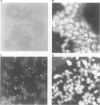Abstract
Investigation of transitional cell carcinoma of the urinary bladder (TCC) patients classified by recurrence and/or progression has demonstrated that loss of chromosome 9, as detected by FISH analysis of the pericentromeric classical satellite marker at 9q12, occurs early. A total of 105 TCCs from 53 patients were analysed in situ by two independent observers for loss of chromosome 9 using quantitative fluorescence in situ hybridization (FISH). All 53 primary tumours were evaluated for chromosomes 9, 7 and 17. Normal ranges for chromosomal copy number were defined for normal skin epidermis and bladder epithelium. Values for chromosome 9 copy number outwith the range 1.51-2.10 (mean +/- 3 x s.d. of normal values) were significantly abnormal. Twenty-five TCCs were detected with consistent monosomic scores. Of 89 TCCs, in which multiple tumour areas were analysed, 85 tumours (96%) demonstrated the same chromosome 9 copy number in all areas (2-6) analysed; only three tumours demonstrated heterogeneity for this locus. A total of 36% (12 out of 33) of patients with subsequent disease recurrence demonstrated loss of chromosome 9 in their primary and all subsequent TCCs analysed. Only a single patient (n = 20) with non-recurrent TCC showed loss of chromosome 9 (P = 0.0085). Of 53 primary tumours, eight showed significant elevation of chromosome 17. Of these patients, six demonstrated elevation in chromosome 7 copy number. No abnormalities were observed in non-recurrent patients. This study describes rapid quantitation of chromosomal copy number by FISH using a pericentromeric probe for chromosome 9 in TCC of the urinary bladder. Routinely fixed and processed material was evaluated without disaggregation. Strict quality control of FISH demonstrated that this technique was reproducible in a clinical environment and could be used to detect genetic changes relevant to patient outcome. It is proposed that loss of chromosome 9 from primary TCC of the urinary bladder identified patients at high risk of recurrence and possible progression.
Full text
PDF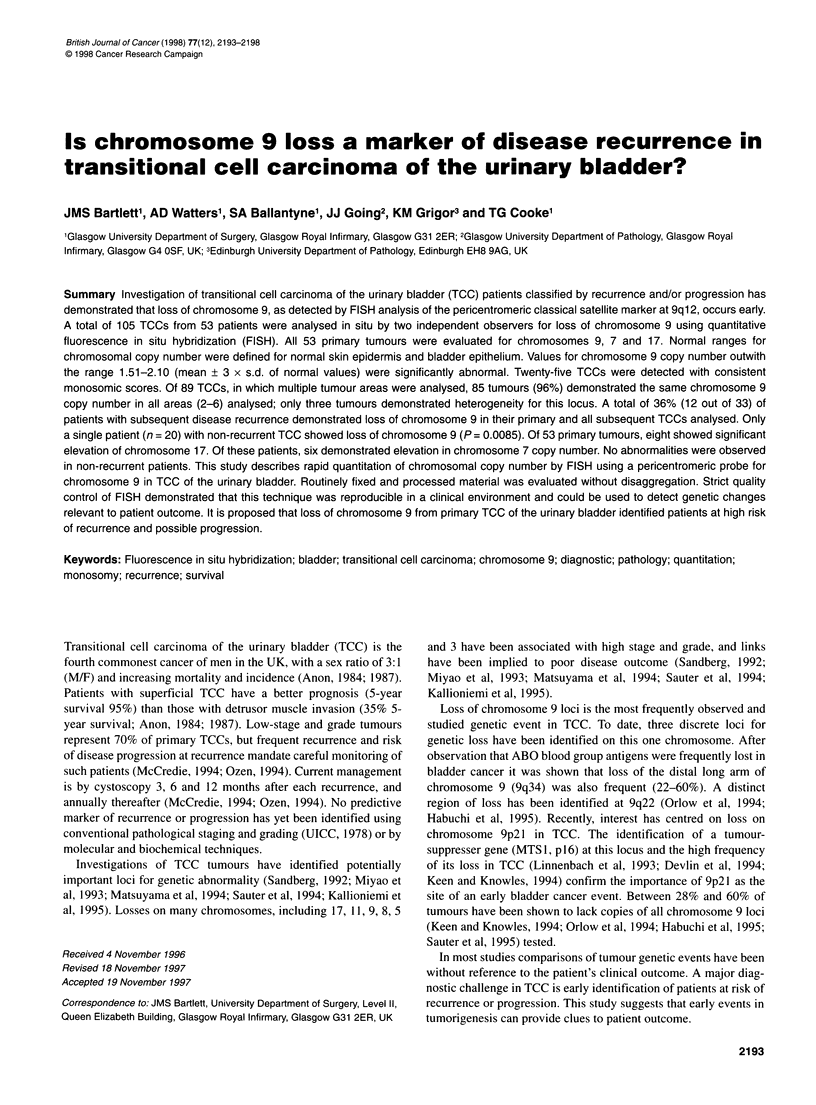
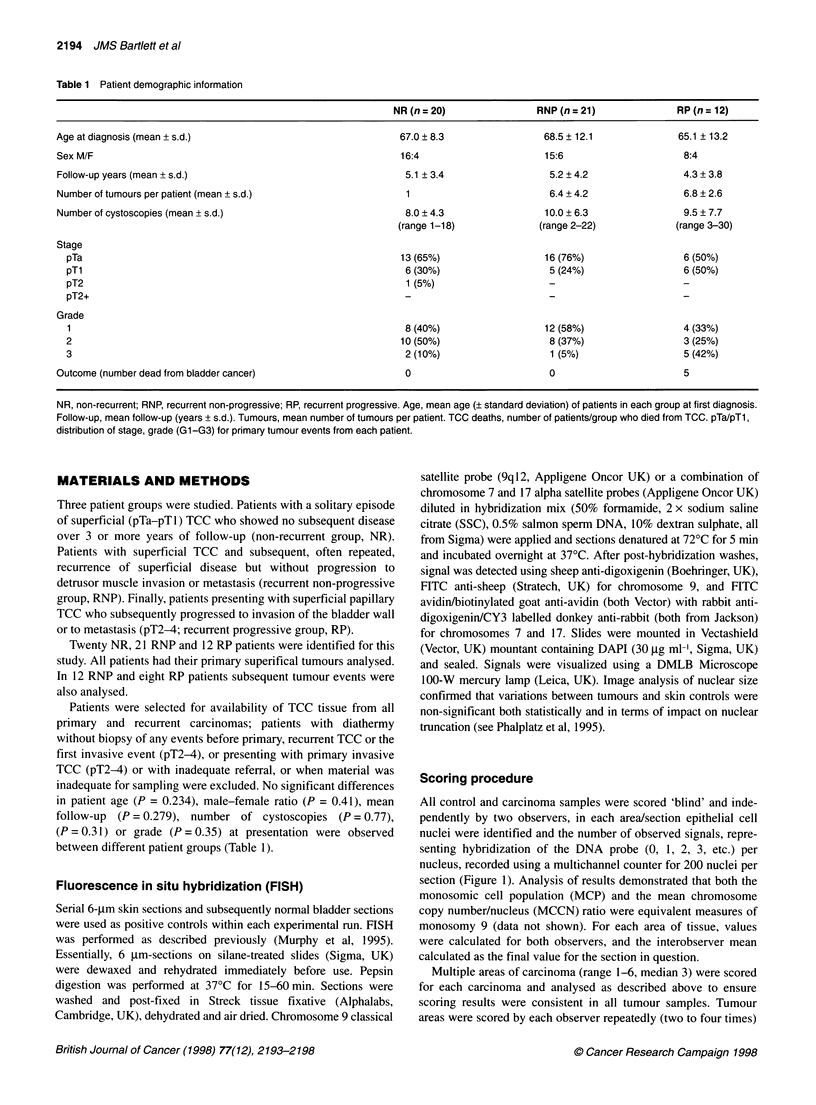
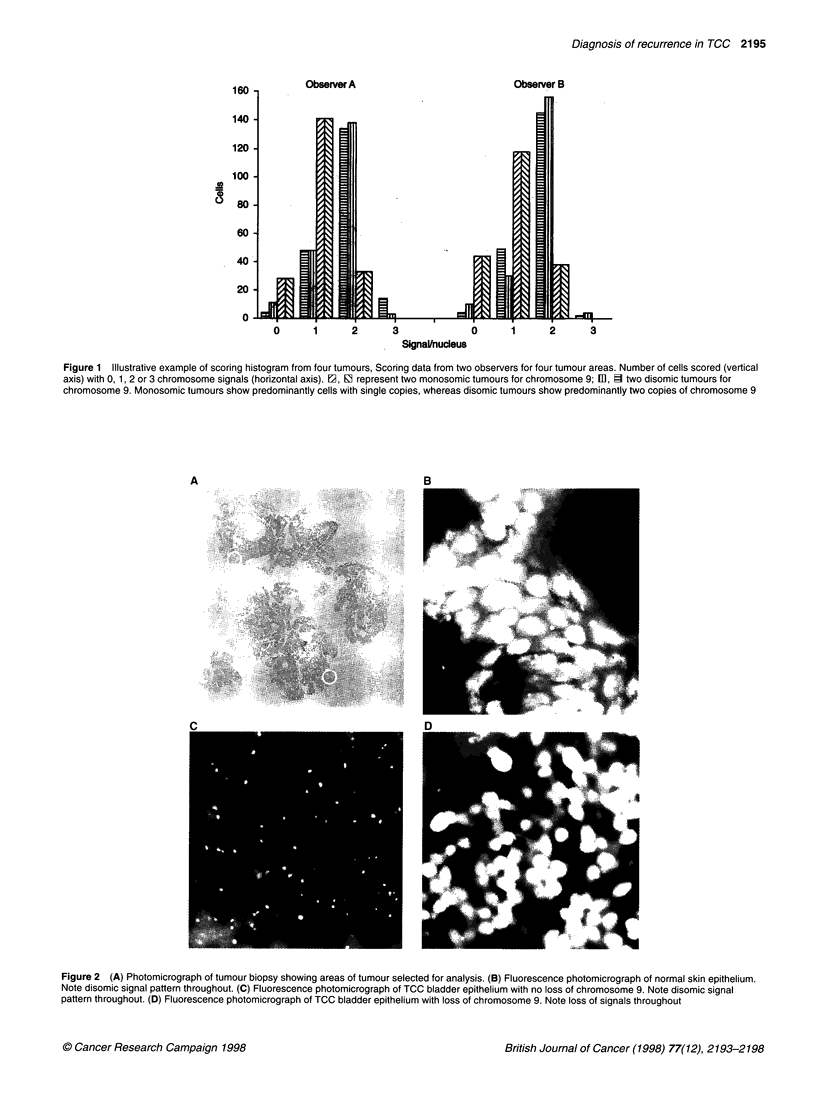
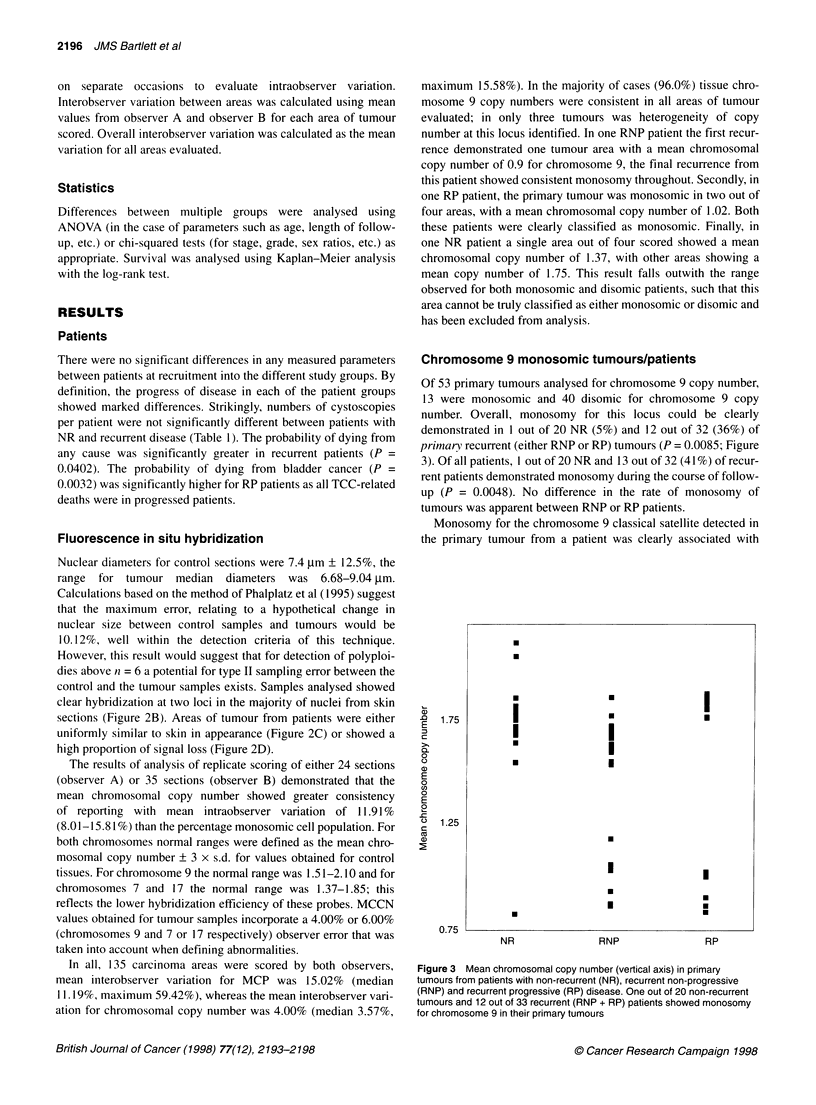
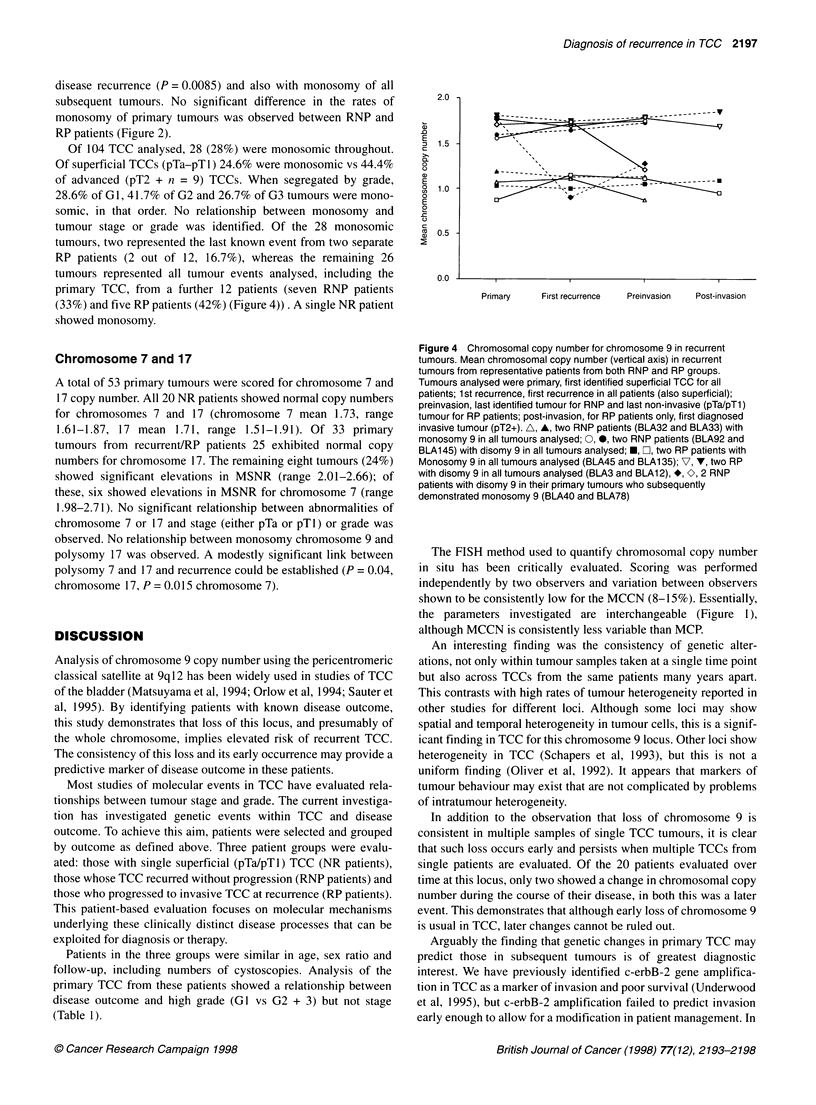
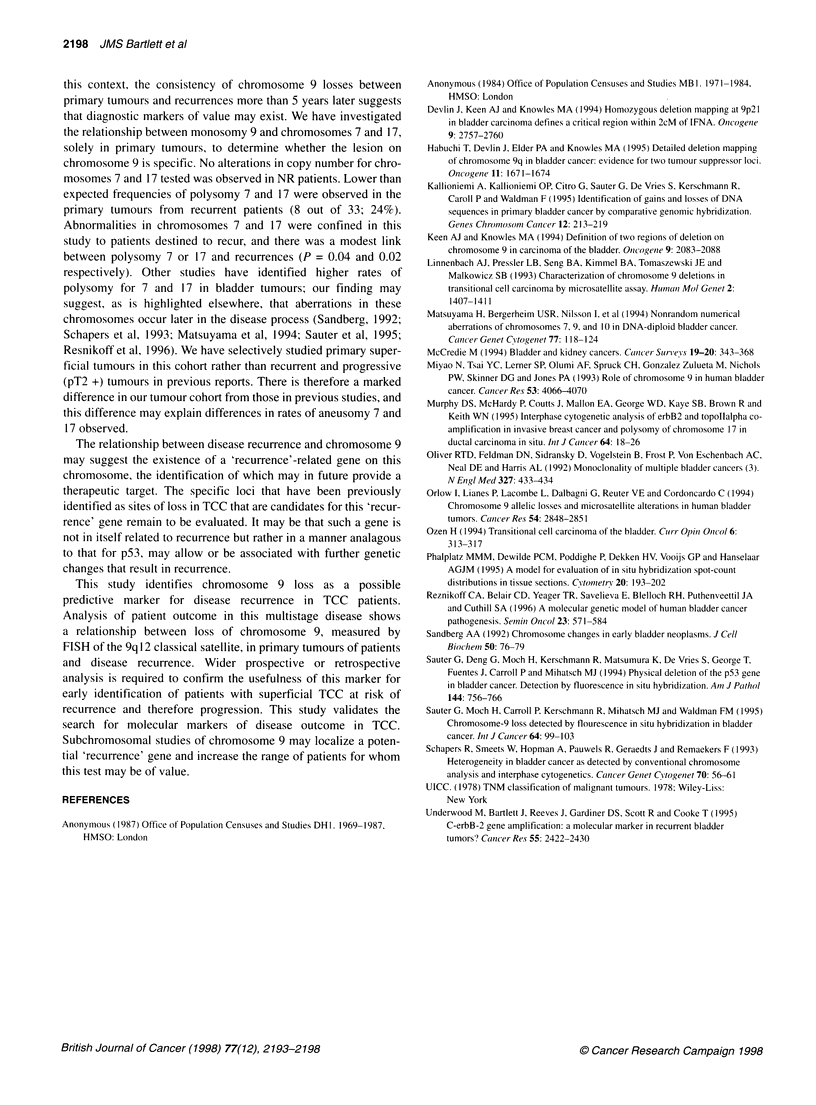
Images in this article
Selected References
These references are in PubMed. This may not be the complete list of references from this article.
- Devlin J., Keen A. J., Knowles M. A. Homozygous deletion mapping at 9p21 in bladder carcinoma defines a critical region within 2cM of IFNA. Oncogene. 1994 Sep;9(9):2757–2760. [PubMed] [Google Scholar]
- Habuchi T., Devlin J., Elder P. A., Knowles M. A. Detailed deletion mapping of chromosome 9q in bladder cancer: evidence for two tumour suppressor loci. Oncogene. 1995 Oct 19;11(8):1671–1674. [PubMed] [Google Scholar]
- Kallioniemi A., Kallioniemi O. P., Citro G., Sauter G., DeVries S., Kerschmann R., Caroll P., Waldman F. Identification of gains and losses of DNA sequences in primary bladder cancer by comparative genomic hybridization. Genes Chromosomes Cancer. 1995 Mar;12(3):213–219. doi: 10.1002/gcc.2870120309. [DOI] [PubMed] [Google Scholar]
- Keen A. J., Knowles M. A. Definition of two regions of deletion on chromosome 9 in carcinoma of the bladder. Oncogene. 1994 Jul;9(7):2083–2088. [PubMed] [Google Scholar]
- Linnenbach A. J., Pressler L. B., Seng B. A., Kimmel B. S., Tomaszewski J. E., Malkowicz S. B. Characterization of chromosome 9 deletions in transitional cell carcinoma by microsatellite assay. Hum Mol Genet. 1993 Sep;2(9):1407–1411. doi: 10.1093/hmg/2.9.1407. [DOI] [PubMed] [Google Scholar]
- McCredie M. Bladder and kidney cancers. Cancer Surv. 1994;19-20:343–368. [PubMed] [Google Scholar]
- Miyao N., Tsai Y. C., Lerner S. P., Olumi A. F., Spruck C. H., 3rd, Gonzalez-Zulueta M., Nichols P. W., Skinner D. G., Jones P. A. Role of chromosome 9 in human bladder cancer. Cancer Res. 1993 Sep 1;53(17):4066–4070. [PubMed] [Google Scholar]
- Murphy D. S., McHardy P., Coutts J., Mallon E. A., George W. D., Kaye S. B., Brown R., Keith W. N. Interphase cytogenetic analysis of erbB2 and topoII alpha co-amplification in invasive breast cancer and polysomy of chromosome 17 in ductal carcinoma in situ. Int J Cancer. 1995 Feb 20;64(1):18–26. doi: 10.1002/ijc.2910640106. [DOI] [PubMed] [Google Scholar]
- Pahlplatz M. M., de Wilde P. C., Poddighe P., van Dekken H., Vooijs G. P., Hanselaar A. G. A model for evaluation of in situ hybridization spot-count distributions in tissue sections. Cytometry. 1995 Jul 1;20(3):193–202. doi: 10.1002/cyto.990200302. [DOI] [PubMed] [Google Scholar]
- Reznikoff C. A., Belair C. D., Yeager T. R., Savelieva E., Blelloch R. H., Puthenveettil J. A., Cuthill S. A molecular genetic model of human bladder cancer pathogenesis. Semin Oncol. 1996 Oct;23(5):571–584. [PubMed] [Google Scholar]
- Sandberg A. A. Chromosome changes in early bladder neoplasms. J Cell Biochem Suppl. 1992;16I:76–79. doi: 10.1002/jcb.240501317. [DOI] [PubMed] [Google Scholar]
- Sauter G., Deng G., Moch H., Kerschmann R., Matsumura K., De Vries S., George T., Fuentes J., Carroll P., Mihatsch M. J. Physical deletion of the p53 gene in bladder cancer. Detection by fluorescence in situ hybridization. Am J Pathol. 1994 Apr;144(4):756–766. [PMC free article] [PubMed] [Google Scholar]
- Sauter G., Moch H., Carroll P., Kerschmann R., Mihatsch M. J., Waldman F. M. Chromosome-9 loss detected by fluorescence in situ hybridization in bladder cancer. Int J Cancer. 1995 Apr 21;64(2):99–103. doi: 10.1002/ijc.2910640205. [DOI] [PubMed] [Google Scholar]
- Schapers R., Smeets W., Hopman A., Pauwels R., Geraedts J., Ramaekers F. Heterogeneity in bladder cancer as detected by conventional chromosome analysis and interphase cytogenetics. Cancer Genet Cytogenet. 1993 Oct 1;70(1):56–61. doi: 10.1016/0165-4608(93)90131-5. [DOI] [PubMed] [Google Scholar]
- Underwood M., Bartlett J., Reeves J., Gardiner D. S., Scott R., Cooke T. C-erbB-2 gene amplification: a molecular marker in recurrent bladder tumors? Cancer Res. 1995 Jun 1;55(11):2422–2430. [PubMed] [Google Scholar]



